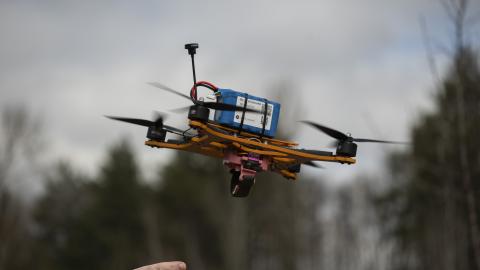Below Hudson Senior Fellow Can Kasapoğlu offers a military situation report about the war in Ukraine.
Executive Summary
- Russian forces continue to advance on Ocheretyne and Chasiv Yar, where Ukraine seeks to stabilize its defensive lines before enemy forces can threaten the T-0504 Highway.
- Evidence emerged this week that Moscow has likely employed chemical warfare agents in Ukraine.
- The Kremlin’s electronic warfare (EW) activities threaten Ukraine, as well as the Baltic and Nordic countries.
1. Battlefield Assessment: Russia Advances on Ocheretyne and Chasiv Yar
The Russian military’s main objective remains the capture of the entirety of Donetsk and Luhansk Oblasts. Current battlefield developments suggest that Russian forces may soon push to seize important cities, such as Kharkiv and Sumy, as a prelude to a larger offensive that will likely begin this summer.
Over the past week, Ukrainian positions near Ocheretyne and Chasiv Yar continued to deteriorate. Evidence suggests that Russian combat formations have advanced on these towns while simultaneously conducting positional fighting in the direction of Siversk. With its sizable troop concentrations, Russia holds the advantage in force-on-force and force-to-terrain ratios against Ukrainian defenses. The Kremlin’s recent territorial gains, and its skill in conducting artillery salvos, could collapse Ukraine’s defensive lines along several fronts.
Reports suggest that Ukrainian ground forces repelled most Russian assaults on Siversk this week and retained control of Ocheretyne and Chasiv Yar. Yet Russia may use a double-pincer maneuver with multi-echeloned assaults to isolate Ukrainian forces near Chasiv Yar and gradually achieve an operational victory there. In addition, Russian control of Ocheretyne would catalyze its military’s advances, opening access to a road leading north to Kostyantynivka, an industrial city in Donetsk Oblast. Open-source intelligence, highlighting artillery scorch data obtained from the battlefield, shows that Russian forces are currently pushing north and west in the region, likely intent on capturing this northbound road that connects to the T-0504 Highway. Because it is the last remaining thoroughfare out of Bakhmut, the T-0504 has been nicknamed the “highway of life.”
While Russia gained momentum from its ground offensive, Ukrainian strikes continued to pound critical Russian assets. The Ukrainian military is putting its Army Tactical Missile Systems (ATACMS) to good use. Geospatial evidence suggests that on May 1, the Ukrainian Armed Forces conducted a successful ATACMS strike on a Russian military site and training ground near Kuban in Luhansk Oblast, where at least one ATACMS unit equipped with a cluster warhead scored a direct hit on a group of more than 100 Russian soldiers.
In another ATACMS strike on May 4, Ukrainian missile forces targeted a Russian Iskander ballistic missile launch site. Available geospatial data and National Aeronautics and Space Administration (NASA) Fire Information for Resources Management System (FIRMS) data confirmed that this strike inflicted significant damage on the Russian facility. Although battle damage assessment data has not confirmed whether Ukraine completely destroyed the site, Kyiv’s ATACMS salvos marked an important operational success for its long-range strike deterrent.
In the meantime, Russia continued to bolster its arsenal at an alarming pace. Vadym Skibitsky, the deputy head of the Main Directorate of Intelligence of Ukraine (GUR), reported that Russia produced approximately two million 122mm and 152mm standard artillery rounds in 2023. Moreover, North Korea has transferred more than three million shells to the Russian military, as well as tactical ballistic missiles. Ukrainian officials have also estimated that, each month, Russia produces over 100 indigenous missiles and receives an additional 330 to 350 Shahed kamikaze drones from its joint efforts with Iran. Finally, the Kremlin’s access to nitrocellulose and ammonium nitrate, critical components used in the manufacture of explosives, are stable this year compared to 2021 and 2023. Russia’s production efforts promise that its war on Ukraine will remain a highly attritional conflict fought at a high operational tempo.
2. Russia Accused of Using Chemical Weapons in Ukraine
Last week, United States officials formally accused the Kremlin of employing chemical weapons and military-grade riot control agents in Ukraine. The US State Department believes that Russia has used chloropicrin, which was widely employed during World War I before it was banned for military purposes and restricted to agricultural use. Reportedly, Moscow has employed the chemical agent on multiple occasions, including in December 2023, when Russian drone warfare assets released caustic and flammable gas on Ukrainian fortifications.
Russian combat formations also reportedly have used quadcopter drones to drop K-51 bombs that disperse chlorobenzalmalononitrile, or CS gas. The K-51 bomb was the Soviet Army’s principal riot control grenade and is still in Russia’s arsenal. The Russian army’s K-51 is more powerful than the police-grade variants of the weapon and can be lethal. Russia’s chemical, biological, radiological, and nuclear defense units have also been deployed in Ukraine with heavy flamethrower TOS-1A Buratino 220mm-class rockets, and have extended their missions to offensive chemical warfare roles.
The Kremlin’s uses of chemical weapons constitute undeniable war crimes and reflect Moscow’s complete defiance of the Chemical Weapons Convention (CWC), an international framework to which Russia is a party.
3. Russia’s Electronic Warfare Capabilities Haunt Ukraine and the Baltics
Ukrainian sources suggest that Russian combat formations are increasingly using Global Positioning System (GPS) signal suppression tactics to curb Western GPS-based precision munitions and affect critical military equipment. Previous Hudson studies have examined how Russia’s electromagnetic warfare (EW) efforts have decreased the effectiveness of Ukraine’s 155mm Excalibur precision-guided artillery shell, a munition that once hit targets with 70 percent efficiency but declined to only 6 percent after Russian EW efforts targeted it.
Ukraine is not the only testing ground for Russia’s offensive EW program. On April 25 and 26, two Finnish civilian aircraft were reportedly exposed to Russian jamming, prompting Finnair to suspend flights to Tartu, Estonia, until the end of May. In Norway, Russian EW efforts also disrupted air traffic and police and emergency services operations. Russia’s EW activity is now an open threat to the Baltic and Nordic regions of the North Atlantic Treaty Organization.














